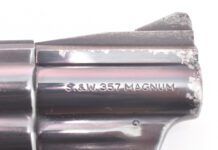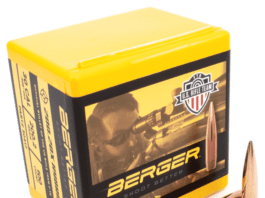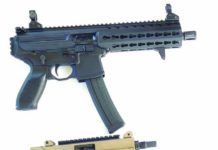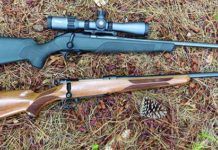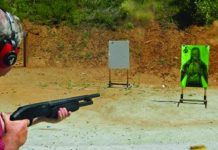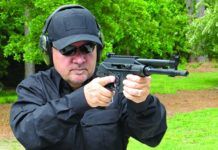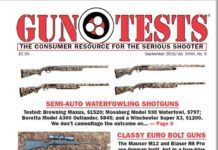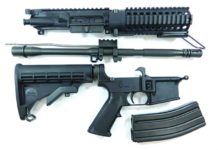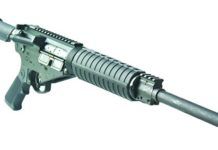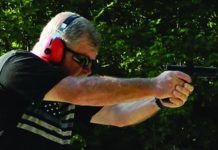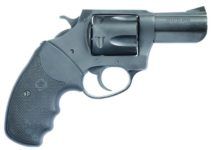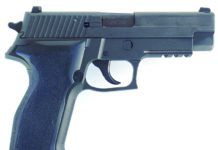9mm Pistols: Uzi Mini Pro, MPA Defender, and SIG Sauer MPX-P
The civilian-available semi-auto versions of what began as expensive SBR's (short-barrel rifles) or true submachine guns are advertised as having good accuracy and reliability while offering a more compact package than a rifle and higher round counts than most handguns. For the task of guarding the castle, we've been around the block a time or two, and have suitable choices for nearly anyone — great pistols, rifles, and shotguns. For this test, we had to suspend any preconceived notions of what we might prefer for home defense and test these firearms based on their own merits. Those merits, we found, are few. If you are shooting for fun and simply making brass, anything that goes bang is suitable. We'll get into the reasons for these judgments, but we like to be clear up front. The SIG Sauer MPX-P is one expensive means of not accomplishing much. The Uzi Pro pistol has drawbacks that made shooting downright frustrating. The MasterPiece Arms Defender proved to be the best of the three and has merit in a defensive situation, within certain narrow parameters. We arrived at this decision by using personal-defense criteria as the overriding factor in providing Buy/Don't Buy advice to our loyal readers. So, in more detail, here are our reasons for making these assessments. Our 9mm Luger ammunition for this test included a 158-grain lead round nose choice from Tomkatammo.com ($18/50 rounds). We also used Black Hills Ammunition 124-grain jacketed hollow points from VenturaMunitions.com ($14/20), a Black Hills Ammunition 115-grain EXP, an Extra Power load not quite in +P territory, also available from VenturaMunitions.com, ($17/20), and a SIG Sauer 115-grain full-metal-jacket load from Cabelas.com ($28/50). Others included the SIG Sauer 124-grain V Crown jacketed hollow point from Luckygunner.com ($16.75/20), and the Hornady American Gunner 124-grain XTP +P from MidwayUSA.com ($14.79/20). We used the Tomkat 158-grain, the Black Hills 124-grain JHP, and the SIG 115-grain FMJ load in benchrest accuracy testing.
Classy European Bolt Guns: Mauser M12 and Blaser R8 Pro
Germany has always been a leader in firearms development both for military and sporting use. The country also has a rich history of hunting. We wanted to take a look at two rifles with Teutonic hunting heritage, so we asked our dealers to wrangle up a Mauser M12 and Blaser R8. If there ever was an iconic bolt-action rifle on both sides of the Atlantic, it is the Mauser. Since 1871, Mauser has produced countless military and sporting bolt-action rifles. Mauser M98 rifles have been copied by many other rifle makers. Hallmark Mauser design features, like the action, three-position safety, and internal box magazine are built into rifles made by companies like Rigby, Winchester, CZ, Kimber, and others. The M12, however, is not a control-feed bolt action but is actually a push-feed bolt like a Remington, Sako, Weatherby, and others.
The Blaser (pronounced BLAH-zer) is a unique take on the bolt-action rifle because it uses a straight-pull bolt and offers interchange barrels in a range of calibers for gophers to elephants. Blazer had made a name for itself as an innovator of luxury hunting rifles, and though it could be debated that this German rifle is over engineered, we found some innovative features on a hunting rifle we didn't know we needed or wanted.
Either rifle would make an excellent deer rifle, we found, as well as top choices to take black bears, wild pigs, speed goats, and other hooved North American game. They both performed well in operation and in accuracy and after spending quality time with them, we can see why they command such a high price.
Both rifles were chambered in 30-06 Springfield, which is the benchmark caliber for American hunting cartridges. Our testers have a lot of experience with the cartridge, and we suspect that every bolt-action hunting rifle currently sold in the U.S. is available in 30-06. The round is versatile, easily found in stores, offers a range of bullet types and weights, and is at the upper level of tolerable recoil, especially when shooting the round out of lightweight hunting rifles. Both of these rifles hovered at seven pounds unscoped. For ammo in this test, we used Black Hills Gold loaded with a 180-grain Nosler AccuBond bullet and two hunting rounds from Hornady: Full Boar with a 165-grain GMX bullet and American Whitetail with a 150-grain InterLock bullet.
We mounted the rifles with the same optic, a SIG Tango6 2-12x40mm ($1600; CheaperThanDirt.com). This is a first focal plane-reticle scope, so the reticle increases and decreases in size as the magnification is increased or decreased. Testers liked this FFP scope because the milling reticle can be used at any magnification to estimate range. The Tango6 is equipped with an illuminated MOA Milling reticle. We could adjust reticle illumination as needed, and if we forgot to turn it off, the scope automatically turns off the illumination after six minutes of rest and powers back on as soon as it senses motion. We would have liked a parallax adjustment knob to really fine-tune the reticle, since we noticed the reticle moved ever so slightly as we moved our head and eye. Not a lot of movement, but enough to note. The scope also features Zerolock turrets, which means you can't lose zero if you rotate the turrets too much in either direction. Turret dials need to be pulled out to make adjustments then pushed back. Adjustments could be felt and seen easily, so getting our dope was simple after bore sighting. All adjustments were clearly marked, which we liked. The magnification ring used two fiber-optic dots that glowed to give the user a heads up on the magnification the scope was set at. Turrets and the magnification ring were toothy, with lots of texture, so rotating the dials was effortless. We could adjust the reticle easily while looking at it on target. For mid-range and typical hunting distances, we think the SIG scope would be a fine choice on these rifles. Where the bullet hits the paper is the real test of how well these rifles will do in the game field and deer stands. Here are the details on these luxury game getters.
What About the 20 Gauge for Home and Personal Defense?
When a shopper is browsing the gun shop for a home-defense shotgun, they are often led toward the 12 gauge rack. The 12 gauge is the universal military and police shotgun and has plenty of power. However, the 12 gauge also has plenty of kick, and in some cases, too much kick for many shooters. Even burly males who do not practice often will find the 12 gauge startling when fired with full-power defense loads. In contrast, the 20-gauge shotgun is usually lighter, easier to maneuver, and offers less recoil. The question is — is it effective?
We have previously tested the .410 bore for home defense and found it surprisingly capable, but the .410 is certainly not in the 12-gauge's power category. The 20 gauge was expected to perform better than the .410 in this job, and it did so, we found. But we also wanted to gauge what happened to the shooter. While the 20 gauge has a greater payload than the .410, is the recoil acceptable for young shooters and female shooters who are smaller than most men. Your body shape, bone structure, and attitude affect how you perceive recoil.
When we discuss the 20 gauge, those who benefit the most are shooters who would not deploy a shotgun if they had to deal with 12-gauge recoil. And the 12 gauge is brutal to some individuals. We are not going to take anything away from the 12 gauge because it is arguably the better choice based on power, but not on practical use, at least not straight across the board. If you find the 12 is controllable, by all means stick with the 12 gauge. But the 20 gauge gives the recoil-shy shooter a good break and heightens the ability to deliver a respectable payload on target. That is the advantage of the 20 gauge.
However, there are practical disadvantages that must be discussed. As an example, when the primary rater was given the assignment to test the 20 gauge, it was several weeks before a suitable low-cost project gun could be located. Finally, a Mossberg Cruiser in 20 gauge was discovered at a small shop and was purchased at full retail because the shop owner would not budge on the price — because the 20 is in demand. By the same token, 20-gauge shells are not available in the wide range the 12 gauge is offered, and sometimes 20's may be difficult to locate. Likewise, parts and accessories, particularly barrels, are more common for defense-related 12-gauge shotguns.
A standard 20-gauge load is the 2.75-inch No. 4 buckshot with 27 pellets. Each pellet is .24 caliber. At about 20 grains each, that is a 540-grain payload. The 20-gauge bore is about 0.61 inch wide, so this is a big payload that creates a serious effect on the target at moderate range. No. 3 buckshot is .25 caliber, and there are 20 pellets. With No. 2 buckshot, you have a 29-grain buckshot at about .27 caliber and 18 pellets in the charge.
5.56mm Pistols from Kel-Tec, Spikes Tactical, and CMMG
It could be argued that the AR pistol evolved out of a desire and need for shooters to own a legal short-barrel rifle-caliber weapon without having to jump through BATFE hoops or pay for a tax stamp to own an SBR (short-barreled rifle). The difference between an AR rifle and pistol comes down to the pistol not being compatible nor able to attach a stock. We wanted to take a look at these AR pistols for home defense and other uses where a compact firearm makes sense, because they offer a number of benefits over a conventional AR rifle, mainly, being more maneuverable while being chambered in a rifle caliber and being compatible with common AR-15 magazines. We acquired three examples, a Spike's Tactical The Jack custom build, a CMMG Mk4 K, and a Kel-Tec PLR-16. The Spike's and CMMG are true AR-15 mechanisms reconfigured to a pistol, while the Kel-Tec uses a different operating mechanism. All three are chambered in 5.56mm NATO/223 Rem. and all are compatible with AR-15 magazines.
We tested these pistols for accuracy, performance, reliability, compatibility with a range of AR-15 magazines, maintenance, ability to be customized, and cost. We found that the Kel-Tec was inexpensive compared to the CMMG and Spike's Tactical pistols. The Kel-Tec, however, needed to be operated differently. The CMMG and Spike's were an easy transition from AR rifle to AR pistol. An AR pistol, as we found out, is nearly as effective as a full-size AR at close to mid range. With the right ammunition, they could be tuned to be a very capable home-defense choice for anyone in the family competent to operate a firearm. Namely, using frangibles to limit overpenetration through walls and doors while still supplying lots of pop.
The AR pistol's edge is its size, but it is also a disadvantage, as an AR pistol is not as easy to shoot as a rifle or a traditional handgun. They are large and require two hands to effectively deliver accurate shots. You could get off a few shots holding an AR pistol with one hand, but the weight of the pistol causes muscle fatigue. A typical full-size handgun may weigh more than 2 pounds loaded, compared to these AR pistols, which weighed from 3.2 to 6 pounds unloaded. Add a pound or more for a 30-round magazine, and you've got a sidearm that would wear out nearly anyone who didn't transport them with a sling, just as you would with a rifle. We used one of the SIG SBX Pistol Stabilizing Braces ($149; SIGSauer.com) and found we liked to use the brace differently than intended, which we will get into shortly.
We also fired the pistols using a Blackhawk Storm Sling ($33.95; Blackhawk.com), a single-point sling with a built-in bungee cord, which many team members felt was an excellent way to carry and control the pistol. We tested with three different AR-15 magazines, including a Brownells USGI CS (Brownells.com; $14) constructed of aluminum, and two polymer magazines, the Magpul PMag Gen2 (Brownells.com; $12.30), and the FAB Defense Ultimag (TheMakoGroup.com; $25). For fast reloads, we also used a Kydex AR magazine carrier from IBX Tactical (IBXTactical.com; $35).
Building an AR pistol is not just a matter of installing a short barrel in a upper receiver and swapping out the receiver extension/buffer tube. Short barrels lose velocity and provide less dwell time for the projectile, so manufacturers need to tune and time the mechanism. A short barrel also needs to work on a range of loads from low- to high-quality ammunition. Reliability can be an issue.
Hands down, the CMMG and Spike's offered more customization than the Kel-Tec because they are compatible with a range of AR-15 aftermarket products — triggers, rails, pistol grips, BUIS, and more. The Kel-Tec is not as compatible. Also, for those testers already familiar with an AR-15, the CMMG and Spike's were much easier to maintain. But there's much more to consider, which we relate below:
Download the Full September 2016 Issue PDF
Patterning performance was a slight disappointment, with a 59-41 pattern using the clay target load and a 62-38 pattern with the steel shot. There was one 3-inch hole in the upper right quadrant of the lead shot pattern and eight hits outside the 20-inch center circle — mainly to the right. Not quite as tight as the Browning, but not considered a deal killer. Just like the Winchester and Browning, the Mossberg features a red fiber optic bar that is quite easy to see and allows for easy barrel alignment on targets. We noted that the checkering on the Mossberg's forearm and stock was a little less sharp than we would have liked and did not have the comfortable feel of the Dura-Touch coating on the Winchester and Browning. It was about the same as the Beretta, although we did not think it severely hindered our handling of the shotgun or our target acquisition.
Waterfowling Shotguns: We Like The Winchester Super X3 Best
Waterfowl sportsmen have greatly changed from the days of market hunters where the daily goal was simply to put huge numbers of birds on the ground in an attempt to satisfy the family dinner needs. Of course, today's waterfowl hunters are strictly limited by migratory bird regulations restricting waterfowl hunting to non-toxic shot with very reduced bag limits on both ducks and geese.
In a way, semiautomatic shotguns designed for waterfowl hunters are like little babies in a beauty pageant. While the parents may think their youngster is the cutest thing on the planet, the pageant judges always apply their own standards and personal preferences in selecting the best in show. This similarity was brought to our attention when a reader asked for a ranking of the best semiautomatic 12-gauge shotguns for bringing down ducks and geese. Without specifying some parameters — such as most used, best handling, affordability, reliability, and a variety of other factors — there can be no single best waterfowl semiautomatic. However, to provide our readers with some options in selecting their best smokepole, we were able to come up with a comparison of four popular, moderately priced semiautomatic waterfowl shotguns. The models included a Browning Maxus, listing for $1520; a Mossberg Model 930 Waterfowl, listing for $797; a Beretta Model A300 Outlander, listing for $845; and a Winchester Super X3, with a suggested retail of $1200. Each was found to feature both favorable and unfavorable elements that varied in importance with each member of our test team. In the end, the patterning-board performance and pocketbook impact proved to be the main separating factors in our ranking.
Our selection of ammunition to test the functioning ability, patterning performance and felt recoil of the semiautomatics included both clay-target loads and a typical waterfowl load. For clays, we used the recently introduced Browning BPT 2.75-inch, 3 dram equivalent loads packing 1 1/8 ounce of No. 7.5 shot with an average muzzle velocity of 1200 fps; and B&P Competition One 2.75-inch, 28-gram loads featuring 1 ounce of No. 7.5 shot with an average muzzle velocity of 1160 fps. To test the shotguns with duck loads, we selected Federal Premium Tungsten 3-inch, 3 dram equivalent No. 2 shot loads with an average muzzle velocity of 1,400 feet per second. Here are our findings:
380 ACP Loads Update: Choices Are Getting More Interesting
In the October 2010 issue we published a report on 380 ACP defense loads. The work was interesting and reader feedback intensive. During the tests, the loads proved accurate and reliable. The problem was the balance of expansion and penetration. We had either adequate expansion or good penetration but not each in the same loading. Some loads penetrated as little as 9 inches, with the average load at 12-13 inches. Expansion was modest in most cases. As a result, we felt that the full-metal-jacketed non-expanding bullet was a viable choice because there was a chance it would reach vital areas and create a stoppage. Surprisingly, even FMJ loads penetrated but 14 inches in water in that test. So, the search was on for a loading that might offer superior performance to the original test choices.
This time, we tested ten different loads using the same media — water and water jugs — and came away with a couple of loads that showed good promise for personal defense.
Since our initial test, many readers have continued to ask us about the effectiveness of the 380 ACP outside the ability to make highly accurate cranial shots. If the bullet cannot be counted on to reach the vitals, then it would hardly be of much use even if it did expand. However, FMJ loads do not necessarily solve every problem. A lightweight FMJ bullet is far more likely to stop short in penetration than a heavier bullet of moderate velocity. Often, a heavier-for-the-caliber-bullet will penetrate more even at lower velocity.
In our experience, modern shooters tend to look at the 380 as a lighter alternative to the 9mm, but a better comparison is between the 38 Special snubnose and the 380. So, as a point of reference, we included a middle-of-the road 125-grain JHP 38 Special +P load fired from a 2-inch-barrel revolver to represent an average for performance with the 125-grain JHP. It makes a striking example of how the 380 ACP fares against what we believe is at least an adequate 38 Special load. Also, for your convenience, we've listed the performance of the first round of 380 ACP loads we tested six years ago. Also, the top-ranked loads from the first test were the Fiocchi FMJ 95-grain No. 380FMJB and Speer Gold Dot 90-gr. No. 23606.
Takedown ARs from DRD, Ruger, Windham: Who Takes the Cake?
Espionage novels and movies are filled with rifles that are transported in a brief case, quickly assembled, then used to fire incredibly accurate shots. But is the ability to transport a disassembled AR in a small case or knapsack more intriguing than practical? Couldn't an AR already be considered a takedown rifle? Can't you just disassemble the lower receiver from the upper receiver and tote the two pieces in a duffle bag? These were a few questions team members had as we started looking into takedown AR-15s.
On one side of the debate, a takedown AR can be discreetly carried without the normal gun case that announces to all what is inside. A takedown AR is something one might consider adding to his bug-out gear should flood, fire, or worse coming knocking on the door. Takedown ARs also have the ability to swap calibers, allowing a user to perhaps opt for 300 AAC Blackout on a pig hunt, use the 5.56mm NATO for home defense, and 9mm for low-cost training. This caliber-swap feature gives these ARs the ability to use whatever ammo is available at the moment. We've all experienced the ammunition shortages of the recent past, and there is no reason to think it won't happen again. These ARs can feed whatever ammo is available. Another plus on the takedown AR side is easier cleaning.
On the other side of the debate, parts that are assembled and reassembled wear faster than parts that are fixed, and the more complicated a design, the more likely it is to break and the harder it is to get spare parts. Also, we wondered how zero might shift when removing then replacing the same-caliber barrel? And, how would a different caliber affect point of impact? Of course, price is always a consideration, and the cost of these takedown ARs is high — more than four times the cost of an entry-level 5.56mm AR priced at about $550. Can't a shooter just buy two rifles and set them up with optics at the same cost or less?
To answer these and other questions, we gathered three models from DRD Tactical, Ruger, and Windham Weaponry. These manufacturers have taken the modularity characteristics of the AR to a new level, each offering its own unique takedown design. Operationally, the DRD and Windham are direct-gas-impingement models; the Ruger uses a piston system.
All in, these takedown rifles get smaller by separating the barrel from the rail, which we estimate as a reduction in length of about 8.5 inches. With all three takedown ARs, the rifle is broken down into three main components. One thing to note: The rails or handguards on these rifles are not compatible with aftermarket parts. You must use the handguard the AR is shipped with because it is a key part of the takedown design. You can, however, customize these ARs with other aftermarket parts like stocks, pistol grips, triggers, sights, controls, muzzle devices, and so on.
American AK-Mag Variants II: Century, RRA, CMMG Go At It
Last month, we began testing AK-pattern rifles built in the U.S., which itself is important to a lot of Gun Tests readers, but also because we wanted to take an in-depth look at the category of what we hoped might be "improved" domestic variants of this famous rifle. Over the years, we've admired various AKs for their reliability while we've criticized their accuracy, fit and finish, and shooter-experience packages, such as crappy triggers and uncomfortable stocks. That said, we were very pleased with three rifles we tested in the June issue, rating one as a Grade A gun (Palmetto State Armory AK-47 MOE Edition 7.62x39mm, $749), a second as a Grade A- rifle (Century Arms RAS47 Magpul-Zhukov 7.62x39mm, $800), and the third a B+ (Palmetto State Armory AK-47 Gen2 Classic Red 7.62x39mm, $849).
This time we pit what are probably the two most significant military rifle actions of the 20th century against each other, the Kalashnikov and the Stoner. But there is a twist: All four rifles are American made, are chambered in 7.62x39, and use Kalashnikov-pattern magazines. The two Kalashnikov actions are made by Century Arms and look very much like standard AK-pattern rifles. The two Stoner actions, made by Rock River Arms and CMMG, for the most part look like the AR-15 platform familiar to many shooters but have some unique features. The Kalashnikovs have a well-deserved reputation for reliability, and the Stoners have a well-deserved reputation for accuracy. So, how would they do head to head?
To find out, we fired all four rifles in both cold and hot conditions, and because we expect these rifles to be used both as plinkers and for hunting or rural self defense, we used four different types of ammunition for this test: 122-grain FMJs, 123-grain plastic-tipped hollowpoints, 124-grain soft points, and 154-grain soft points. Due to the fairly big groups shot with open sights at 100 yards last time, this round we fired five-shot groups at 50 yards and measured them from center to center. Here's what we learned.
Glock Night Sights: We Test Glow-in-the-Dark Aiming Aids
As a carry handgun, the Glock is rugged, reliable, and combat worthy. About the only modifications that actually improve the Glock are the addition of a better trigger and a set of aftermarket sights. We dealt extensively with the issue of trigger replacements in the April 2014. There, we installed a Zev Technologies' GlockWorx Ultimate kit from Brownells.com ($250, #100-006-566WB, Mfr. Part: ZTFULULT4G9BLK) into our Glock 17. We gave the Ultimate Kit an A grade, saying it "was the upgrade that produced the biggest difference in performance all by itself, increasing the accuracy of the Glock 17 from an average grouping of 2.3 inches down to 1.6 inches."
Also in the April 2014 issue, we looked at two sight-upgrade kits, both from Brownells. One was the Brownells Glock 17 Sight Upgrade Kit ($200, #080-000-919WB), which included a Meprolight (Kimber) ML-10224 Tru-Dot Night Sight System for Glock 17, 19, 22, 23, 31, 32, 33, 34, 35, 37, 38, 39; an MGW Glock Sight Adjustment Tool, and an Ed Brown Front Sight Tool for Glock. Since we had the installation tools handy, we also ordered a set of TruGlo tritium fiber-optic Brite-Sites ($90, #902-000-107WB, Mfr. Part: TG131GT1Y), yellow rear and green front. We chose to put the TruGlo sights on the Glock 17 and the Tru-Dots on a G34 so that we could shoot them side by side.
With the Ed Brown Front Sight Tool for Glock ($20 sold separately, #087-017-001WB, Mfr. Part: 952) and the MGW Glock Sight Mover ($100 sold separately, #584-045-017WB, Mfr. Part: MGW309) for the rear sight, we started the switch with a disassembly of the slide to get access to the front sight. With the Ed Brown front sight tool and a small crescent wrench, we loosened the screw beneath the sight and removed it, then replaced the white dot with the new TruGlo front sight and tightened with the crescent wrench. Once the front sight was swapped, we hooked the slide into the MGW. The device came with some thin plates to raise the slide up the right height. We did not need them. The old sight drifted out with relative ease, going left to right pointed away from us. The new rear TruGlo sight did require some minor fitting with a file and a little more strength to slide in, but with the MGW tool, leverage was not a problem. We used the same process to put the Meprolite sights onto a factory Glock 34.
Despite the new TruGlo sights being fixed like the originals, we found them to be much clearer and easier to acquire and reacquire targets. We took to the range with the TruGlo sights installed, using all other original parts, and we cut our average group size down by almost half an inch, from 2.3 inches with the standard Glock to 1.9 inches with the TruGlo sights. We turned down the lights over the shooters, leaving the targets illuminated to check out how much the tritium would glow in the fiber-optic sights. The green front sight was quite bright, while the rear yellow sights were significantly dimmer, although still visible.
The Meprolight Tru-Dots provided an even more impressive change on the G34. We shaved just over a full inch off our average group size at 10 yards once we installed them.
Upgrading fixed sights can seem like a challenge to someone who hasn't done work on pistols previously, but with these tools and the simplicity of Glock's designs, this upgrade is a great place to start if you want to attempt a DIY project. You can drift the sights out with a punch, which will save $100 for the MGW tool, but you risk rupturing the tritium capsules. The MGW mover requires oil on the crankshaft, but it made drifting the dovetail sights in and out so easy we quickly misplaced our punch set. Overall, we found the TruGlo sights to be a nice upgrade and would recommend putting them in place of the standard non-tritium sights on any factory Glock. We gave them a Grade: A ranking, along with the Meprolight Tru-Dot tritium.
Naturally, readers asked about other sights, so we began looking at more replacements we could test head to head, rather than as a general Glock upgrade. So, again working with Brownells, we assembled a sextet of night sights suitable for installation on various Glocks. Also, we believe you can broaden our recommendations to include other firearms of similar size — the visual presentation won't be appreciably different on different platforms — though the installation process may differ gun to gun.
Snubbies, the Taurus Recall, and Trump on Guns
Regarding the Taurus settlement and the problems Lou had with his pistol: On August 4, 2015 I sent Taurus my PT-111 Pro and two magazines. Their website was very poor about updating progress of the return, but by 12/16/2015 I did have a new PT-111 G2 with two mags, all new in the box. I had to pay $25 for the FFL transfer fee, but I was reimbursed by 1/15/16. I am actually quite pleased with the new gun. To get reimbursed, I faxed an itemized receipt to Taurus at (305) 624-1126. I hope this helps Lou and perhaps others.
40 S&W Shoot Out: Beretta, CZ-USA, Ruger, and SIG Sauer
Pistols chambered for the 40 S&W round often are the odd man out as the first choice of a citizen contemplating arming himself or herself. Most of us choose the 45 ACP for its terminal performance and the 9mm Luger for capacity. Here, though, this report is in part a continuation of 40-caliber ammunition tests we conducted some years ago. One of our raters has much field experience and favored the 45 ACP and did not give the 40 S&W much attention.
After empirical testing, he came to the conclusion that the 40 is more like the 45 than the 9mm in terminal ballistics, and that's a good place to be. This rater also tested compact and subcompact 40-caliber pistols and came away believing that forties lighter and smaller than the Glock 23 are too much for most shooters to handle well. So, it was logical that he gravitated toward service-size 40 S&W handguns as the right fit of cartridge and pistol.
Full-size handguns are among the most common 40 S&W handguns chosen for home and personal defense. They are relatively mild to fire and reliable.
With these facts in mind, we wanted to test four 40-caliber handguns of different configurations to see which one suited our testers the best. Also, we went looking for value, shooting two brand-new guns against veterans which, perhaps, still had some game left in them. The two new guns were a selective-double-action CZ 75B and the double-action-only Ruger SP40, which we found listing around $580 and $569, respectively. The other choices were the double-action first-shot SIG P226R and the double-action first-shot Beretta 96 Vertec Inox, the latter a used model and the former was a factory rebuild offered by SIG Sauer.
The Beretta Model 96 Vertec has received praise from us before, being named a Gun of the Year in 2005 after being evaluated in the April 2005 issue. We said then, "Alloy 40 S&W pistols have a well-earned reputation for packing plenty of power in their lightweight frames, but they are also well-known for being vicious kickers for the training shooter. However, the Model 96 Vertec was an exception." In particular, we liked the vertical grip design that, combined with the thinner grip panels and short-reach trigger, made the pistol much friendlier to shooters with smaller hands. We liked it because its flat-sided feel and more rectangular shape were easier to index, that is, get in proper alignment faster. This time we tested the stainless version.
Certified Pre-Owned SIG Sauer pistols like the P226R tested here are often traded in by law-enforcement agencies for new SIGs, and the company puts the pre-owned SIG pistols through a stringent Factory Certification process. Each pistol is stripped, refitted with original factory parts where needed, cleaned, lubricated, function tested and hand-inspected by a factory technician. Each Factory Certified pre-owned SIG comes with a one-year warranty and one standard-capacity magazine. The condition of these pistols will vary depending on the amount of wear, such as that caused by a holster and ring wear, and that condition will be reflected in the retail price. Dings and holster wear and ring scratches are not covered under the one-year factory warranty.
We tested a similarly set up CZ 75Bpreviously (May 2009), but chambered in 9mm. In that test we noted the accuracy of the CZ was about 2.5 inches for all shots fired at 15 yards. We also noted the heavy CZ dampened 9mm recoil, and there were no problems with the CZ whatsoever. It appeared to be very well made and built to last. We looked forward to testing the 40 S&W version.
Likewise,we tested a Ruger SR40previously, most recently in the October 2011 issue. In that review, we said, the SR40 was remarkably underrated, and it might be a plastic gun for people who don't like plastic guns. We said, "Its slender profile makes it more controllable than most high-capacity guns, and it's a good candidate for concealed carry, too. We liked having manual safeties even if they weren't perfect. Though not match grade, we thought the trigger was predictable with a reasonable sense of take-up and overtravel." That model was the BSR40, with an all-black color scheme and a 15+1 capacity, which is now listed by the company as Model 3471. This new SR40 is Model 3470, still with the same 15+1 capacity, but this time with a brushed-stainless-steel slide.


















